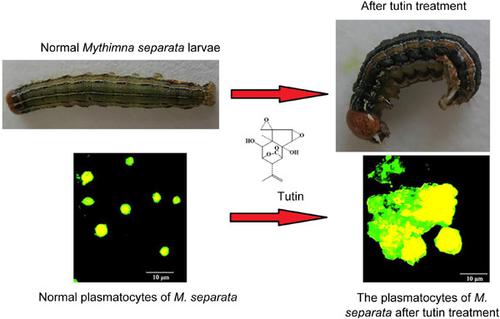当前位置:
X-MOL 学术
›
Arch. Insect Biochem. Physiol.
›
论文详情
Our official English website, www.x-mol.net, welcomes your feedback! (Note: you will need to create a separate account there.)
Biocidal efficacy of tutin and its influence on immune cells and expression of growth‐blocking and neuroglian peptides in Mythimna separata (Lepidoptera: Noctuidae)
Archives of Insect Biochemistry and Physiology ( IF 2.2 ) Pub Date : 2021-04-09 , DOI: 10.1002/arch.21767 Feifei Li 1 , Jun Cui 1 , Tayyab Shaheen 1 , Guanghui Tang 1 , Tao Wang 2 , Tracy Woolfley 2 , Menglou Li 1
Archives of Insect Biochemistry and Physiology ( IF 2.2 ) Pub Date : 2021-04-09 , DOI: 10.1002/arch.21767 Feifei Li 1 , Jun Cui 1 , Tayyab Shaheen 1 , Guanghui Tang 1 , Tao Wang 2 , Tracy Woolfley 2 , Menglou Li 1
Affiliation

|
Mythimna separata Walker (Lepidoptera: Noctuidae) is one of the major pests that can cause severe damage to grain crops. The development of low‐toxicity and high‐performance botanical insecticides is becoming the focus of new pesticide research to control M. separata. Tutin, a sesquiterpene lactone compound obtained from Coriaria sinica Maxim, a native Chinese poisonous plant, has antifeedant, absorption, and stomach poisoning against a variety of pests. To understand the toxic effect of tutin on M. separata larvae, we set out to determine their antifeedant, mortality, paralysis, weight change, and to examine the spreading of M. separata hemocytes under different concentrations of tutin treatment. Tissue distribution of the immune‐associated gene growth‐blocking peptide (GBP) and neuroglian peptide (Nrg) was detected by reverse transcription polymerase chain reaction (PCR). Furthermore, real‐time quantitative PCR was carried out to determine the expression profiles of GBP and Nrg after different concentrations of tutin stimulation. Our results revealed that tutin exhibited significant antifeedant and insecticidal activities, paralysis, weight loss to M. separata. Besides, tutin significantly influenced on the morphology of hemocytes and enhanced the expression of GBP and Nrg in M. separata.
更新日期:2021-05-11



























 京公网安备 11010802027423号
京公网安备 11010802027423号